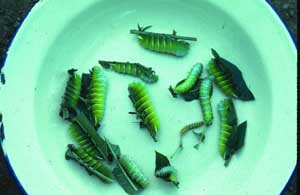|
|
 49 starvation DHJanzen100642.jpg high resolution
|
|
| But in this method of rearing large numbers of larvae on limited food, some larvae get a lot of food and some get quite a bit less. The results are symbolically displayed here, with the plate containing the full range of instars from a batch of eggs that all hatched in a two day period. There is one third instar, many fourth instars, and two fifth instars. All the males will spin cocoons in about 20 days from the hatching date, and the females about 23 days from the hatching date, but with substantial variation. A dilemma emerges. What is a caterpillar to do? It can have a calendar that says, OK, you have fed for 20 days, so now you spin and later eclose whatever is the consequent size. Or, it can feed until it has reached a certain size, then spin, to eclose the same size as your sibs who have the same strategy. To make a long story short, Rothschildia lebeau combines the two strategies. The very small third instar in this image will not grow to be nearly as large a 5th instar as its sibs, but it will grow to be at least a 5th instar and spin at a smaller size, and feed as long as do the longest-feeding females, even though it is a male. The consequences of this strategy are quite interesting. | ||
back to lecture slides
or skip to: